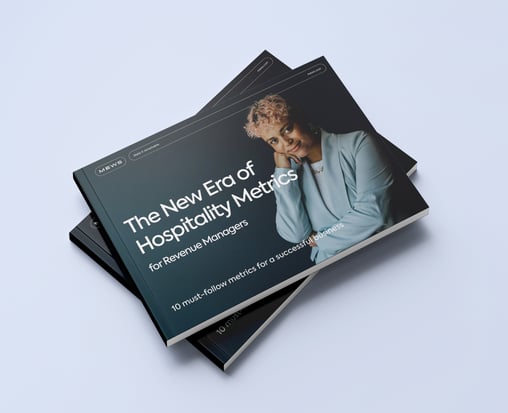What are hotel rates?
Hotel rates are the prices hotels charge per night for their rooms and any related services.
These rates are dynamic and may vary significantly depending on several factors, including the type of room, the season, and the level of competition in the area.
In order to set the rates, hoteliers must take many different factors into consideration. They have to think about their expenses, such as the cost of maintaining the property in good condition, staff salaries, and all the amenities they offer, and, of course, the need to make a reasonable profit.
Throughout the year, prices could increase or decrease significantly. This depends on the season, whether there's a big event happening in town, or simply on the number of people making reservations at a given moment.
In addition, hotels play around a lot with their pricing strategy to attract different types of customers. For example, they could offer premium rates during periods of high demand or promotional discounts during the low season to attract more customers. This approach to adjusting prices helps hotels keep a steady income and adapt to both market changes and customer preferences.

15 Types of Hotel Rates
Understanding and choosing between different types of hotel rates is essential for maximizing occupancy and revenue. So here are 15 different types of rates, each with its own benefits and key strategies.
1. Standard or RACK rate
The standard rate, commonly known as the RACK rate, represents the highest cost of a room, with no discounts or additional extras included. This is the price you will normally find published on the hotel's website or in its official price list.
Many hotels opt to offer two versions of the RACK rate, one with breakfast and one without. This strategy allows guests to select the most suitable option for their needs and budget.
Additionally, this rate serves as a benchmark for setting more competitive and promotional prices. Therefore, it is essential to take this into account when setting hotel prices and establishing marketing strategies aimed at maximizing occupancy.
2. Best available rate or BAR
The Best Available Rate, known by its acronym BAR, is the cheapest rate that guests can get at any given time. There are two main versions of the BAR rate: the dynamic rate and the daily rate.
The dynamic rate changes depending on room availability. For example, the price may be lower when occupancy is 0-20%, and increase as more rooms are occupied. This system promotes early bookings when there is more availability.
On the other hand, the daily rate is set according to the day of the week, reflecting a fixed price structure that changes with each day. This sometimes means that staying from Sunday to Tuesday costs less than staying over the weekend.
3. Non-refundable rate
Under this rate type, guests are required to pay for their entire stay in advance, and as the name suggests, no cancellations or changes are allowed.
If, for any reason, the guest is unable to use the reservation, the amount already paid will not be refunded. Despite these restrictions, this rate usually offers a significant discount compared to standard rates, often with 5-10% price reductions.
Given the uncertainty caused by situations such as the pandemic, there has been a slight decline in the popularity of non-refundable rates. However, for travelers who have fixed plans and are looking for the best deals, these rates are still an excellent option.
4. Last-minute rate
Last-minute rates are perfect for those who book their accommodation at short notice or even directly upon arrival at the hotel.
This option offers lower prices compared to standard rates, and is a strategy that hotels use to ensure that they do not end up with empty rooms.
The discount offered on last-minute rates may vary, but it is usually between 10% and 15%. They are activated within 24 to 48 hours before the arrival date, encouraging potential guests to make a quick decision and benefit from reduced prices.
5. Early booking rate
In contrast to the previous rate, the early booking rate is an excellent option for those who plan ahead and know for sure when they will be traveling.
This type of rate provides a considerable discount for reservations made well in advance, usually between 30 days and 6 months prior to the arrival date. Moreover, this rate often includes conditions such as non-refundable advance payments, which implies a firm commitment on the guest's part.
For hotels, this is an effective strategy for stabilizing their revenue stream and optimizing their resources and services. For guests, it represents an opportunity to ensure a good price, knowing that their early planning has a tangible reward.

6. Length of Stay Rate (LOS)
The length of stay rates, also known as LOS, offers a discount that increases with the number of nights the guest decides to stay.
This is very attractive for both travelers and hotel managers, as the longer the stay, the lower the relative cost of maintaining the room and the greater the chances that the guest will spend more on hotel services such as restaurants, spa, or recreational activities.
In addition, longer stays often result in better reviews, as guests develop a greater connection and familiarity with the place and the staff.
7. Promotional rate
Promotional rates are excellent for increasing room sales, especially during the low season. These may include incentives such as "two nights for the price of one" or include a free breakfast or free parking.
In addition, many properties implement promotional codes that guests can use when booking directly through the hotel's website. These codes often offer exclusive discounts to guests who have already stayed at the hotel or those subscribed to the mailing list, providing added value that encourages loyalty and long-term engagement.
8. Board Basis Rates
These rates are usually classified as: B&B (Bed and Breakfast), HB (Half Board), FB (Full Board), and AI (All Inclusive).
Each of these options caters to different needs and preferences, allowing guests to choose based on their travel plans and priorities. At the same time, these types of rates may vary depending on the location and type of hotel. For example, an all-inclusive package is very common in beach destinations such as the Caribbean, but not so much in large cities where there are plenty of dining options.
9. Family rate
These rates are specially designed for those traveling with children. They usually include additional beds in the room at no extra cost and often also include benefits such as a buffet breakfast and access to recreational facilities such as the swimming pool. In addition, you can offer discounts on activities designed for the whole family.
This type of rate positions the hotel as an ideal destination for family vacations, increasing customer loyalty and the chances of positive recommendations.
10. Corporate rate
These special rates are designed for guests who visit the hotel frequently for business purposes. In many cases, corporate rates are often negotiated directly with companies, providing them with competitive and exclusive prices that are not available to the general public.
This type of rate may include additional benefits tailored to the needs of business travelers, such as breakfast included and more flexible cancellation policies, among others.
Setting a corporate rate not only encourages corporate loyalty to your hotel but also ensures a steady stream of reservations, which is especially valuable during periods of low tourist demand.
11. Group rate
These rates are ideal for hotels capable of accommodating large groups of people traveling for corporate events, conferences, sightseeing tours, weddings, or any other purpose.
These rates offer great discounts for the group and, at the same time, ensure that the hotel fills several rooms at once. These rates are usually negotiated and set with travel agencies, event organizers, or wedding planners.
Hotels can set a minimum number of rooms or guests to qualify as a group, and, on that basis, offer special conditions that may not only include reduced prices, but also payment and cancellation policies tailored to the group's needs.

12. Half-day rate
Half-day rates are especially useful in hotels located near airports or in properties that cater to business guests.
This option allows travelers to rent a room for a few hours, which is ideal for those who need a short break between flights or a quiet space to work during the day.
This option also offers the advantage of being able to rent the same room twice in one day, for example, in the morning and then again for an overnight stay. However, it is important to keep in mind that this may present logistical challenges for your housekeeping and maintenance operations.
13. Complementary rate
Complementary rates, also known as courtesy rates, are a special type of rate that is not advertised online, but is managed exclusively through the hotel's PMS. This rate is set at 0 euros and is used to offer free stays to certain guests under specific circumstances.
These rates are generally applied in cases such as compensation for a previous inconvenience, for PR purposes, or for collaborations with influencers and the media, or even for hotel staff during training trips.
14. Flexible rate
These rates allow guests to cancel or modify their stay without penalty up to a certain time limit before the date of arrival. This flexibility often comes at a higher cost than more restrictive rates, such as non-refundable rates.
In a post-pandemic world, flexible rates have become especially popular. Many travelers value the ability to adapt to unexpected changes without incurring extra charges.
15. Loyalty fee
Some studies state that acquiring new customers can be 5 to 25 times more expensive than retaining current ones. That's why offering special rates to returning guests is a smart way to keep them coming back.
Loyalty rates often include discounts and exclusive offers for members of loyalty programs, similar to Booking's Genius or Expedia's Rewards programs, where the hotel absorbs the cost of the discount offered.
Offering this type of rate not only improves customer loyalty but also increases the likelihood of recommendations and positive reviews, amplifying the positive impact on the hotel's reputation and profitability.
The Best Strategies for Managing Hotel Rates
Here are some of the most effective strategies for managing your accommodation's costs:
Know your product
Understanding exactly what product we are offering is essential. Trying to sell a bungalow in a campsite on the Mediterranean coast is not the same as offering a suite in Vancouver. When we know exactly what we're selling, we can get a clearer idea of which market we should be targeting.
Identify your target audience
Once you have clearly defined the product or service you offer, you need to identify your target audience as well as the market segment you want to reach. Just like with the product, engaging a tourist looking to book rooms at a capsule hotel in Tokyo is not the same as targeting a couple looking to spend several nights in a cabin with a sauna by a lake in Finland.
By understanding our target customer, we can make decisions about which rates are appropriate and which ones may be more competitive in the market.
To obtain this information, you should rely on market research to help you identify what your competitors are doing and keep up to date with trends in the hotel industry.
Apply dynamic pricing
This flexible approach allows you to adjust your rates in real time based on demand. It's quite straightforward: when demand increases, you should raise your rates; and when demand decreases, you should lower your prices. In short, the pricing is ruled by the law of supply and demand. Its main advantage is that during peak season, more revenue is generated, and during the off-season, we are able to maximize occupancy by offering more competitive prices.
Be flexible
Since it is difficult to have everything standardized and under control, it is important for hotel managers to understand the importance of adapting rates to external events and unforeseen circumstances, regardless of whether they are negative or positive.
For example, if demand unexpectedly drops due to the outbreak of an armed conflict (a war like the one in Ukraine, an attack like the one in Barcelona in 2017, etc.), a natural disaster (unexpected snowfall, torrential rain, etc.), rates should be adjusted accordingly. On the other hand, if a movie or a celebrity has made a particular destination or hotel fashionable, then we must be aware and adapt our rates to the reality of the situation at that time.
Use a revenue management software
These systems help hotels to better manage their revenue. Their approach is very simple: they monitor demand and make hotel occupancy forecasts in order to optimize and customize rates according to the season, demand, or any unforeseen circumstances.
This technology is compatible with PMS software, making it very convenient, as you can automatically adjust your rates according to pre-set parameters.
Integrate hotel PMS software
PMS (property management systems) are specific tools that help hotels optimize their rates and revenue. Integrated with the operations that flow from your hotel's front desk, they allow you to predict demand, adjust or set room rates, and track occupancy and inventory.
Optimize your hotel's rate management with Mews PMS
If math isn't your cup of tea and you don't know how to manage your hotel rates, today is your lucky day, because we're presenting you an easy-to-use and versatile rate and revenue management software that's perfect for optimizing inventory and increasing your business's profits: Mews Hotel Revenue Management Software.
Your rates, your rules
With Mews PMS, you can create and customize product rates, as well as apply your own rules to tailor them to your hotel's needs.
You will be able to set the system to automatically update rates according to real-time demand: for example, if you experience high demand due to a major convention in the city, the software will instantly increase the rates you want, and vice versa, it will adjust them downward if there is low demand. Without a doubt, this approach proves to be effective if you are looking to improve your occupancy and profitability.
Create package rates
Another major advantage of our revenue management software is that it streamlines the management of package rates, as the software itself automatically adds products to create packages in the reservation. It also allows you to set your own rules regarding which products and rates to include in each package, which will help attract guests with appealing options during the booking process.
Integration with RMS tools
Thanks to Mews Open API, you can integrate your software with any RMS (Revenue Management System). You'll be able to easily connect your custom revenue management tools or find the most suitable RMS for your business on Mews Marketplace to help increase your hotel's revenue.
Set base prices
Mews RMS lets you set base prices that guarantee a minimum revenue from your rooms and ensure your hotel is profitable.
Manual pricing
In addition to automating rate adjustments, Mews RMS also allows you to override your pre-set rules and manually change rates whenever you want, for example, on specific dates, certain days of the week, or for selected room categories.
Dependent rates
Create rates that are linked or dependent on other rates. For example, you can create a base rate that will be linked to other rates so that any future changes you make to the base rate will be reflected and applied to all other dependent rates.
Rate restrictions
Set parameters tailored to your needs, such as a certain occupancy rate or specific holidays, and automatically adjust them to the room rates you choose.
Category settings
Another of the many benefits and features of Mews RMS is the ability to create room and space categories, allowing you to adjust the prices of all spaces in a single category simultaneously.
Conclusion
To sum up, in addition to understanding the product we sell and the type of guest we are targeting, if we want to ensure a successful sales performance, it is essential to implement an effective rate management strategy in our hotel.
It has been proven that creating a solid pricing strategy that includes data analysis and market context, the use of dynamic and flexible pricing, and above all, the use of good pricing management software, ensures that we maximize the occupancy and revenue of a hotel
Download our guide "The New Era of Hospitality Metrics for Revenue Managers"





.webp)
